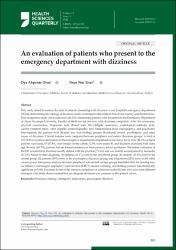| dc.contributor.author | Akpınar Oruç, Oya | |
| dc.contributor.author | User, Neşe Nur | |
| dc.date.accessioned | 2023-05-31T13:50:30Z | |
| dc.date.available | 2023-05-31T13:50:30Z | |
| dc.date.issued | 2022 | en_US |
| dc.identifier.citation | Oruç, O. A., & USER, N. N. (2022). An evaluation of patients who present to the emergency department with dizziness. Health Sciences Quarterly, 2(4), 205-212. | en_US |
| dc.identifier.issn | 2791-6022 | |
| dc.identifier.uri | https://dx.doi.org/10.26900/hsq.2.4.05 | |
| dc.identifier.uri | https://hdl.handle.net/20.500.12933/1573 | |
| dc.description.abstract | This study aimed to analyze the data of patients presenting with dizziness at our hospital’s emergency department (ED) by determining the etiology of dizziness and to contribute to the medical data of our country and the literature. This prospective study was conducted with 116 volunteering patients who presented to the Emergency Department of Afyon Kocatepe University, Faculty of Medicine for one year with dizziness complaints. After the anamnesis, physical examination, diagnostic tests (blood tests, Dix-Hallpike maneuver, audiological-vestibular tests, carotid-vertebral artery color Doppler ultrasonography, and computerized brain tomography), and psychiatric interrogation, the patients were divided into four etiology groups: Peripheral, central, psychogenic, and other causes of dizziness. Clinical features were compared between peripheral and central dizziness groups. A total of 116 (3.4%) of patient admissions to the emergency department complained of dizziness. Forty-nine (42.2%) of these patients were male, 67 (57.8%) were female. In the cohort, 33.9% were under 40, and dizziness increased with older age. Seventy (60.3%) patients had no formal education or were primary school graduates. The initial evaluation at the ED revealed that dizziness mostly shifted with the position (71.6%) and was mainly accompanied by headache (67.2%). Based on their diagnosis, 50 patients (43.1%) were in the peripheral group, 30 patients (25.8%) were in the central group, 22 patients (19%) were in the psychogenic dizziness group, and 14 patients (12%) were in the other causes group. Intergroup analysis between peripheral and central vertigo groups identified that the hearing loss, ear fullness, recent upper respiratory tract infection (URTI), nausea, vomiting, and shifting position was statistically significant (p<0.05). Dizziness is one of the common complaints of admission to the ED and may arise from different etiologies. Our study demonstrated that psychogenic dizziness was common in this patient cohort | en_US |
| dc.language.iso | eng | en_US |
| dc.publisher | Holistence Publications | en_US |
| dc.relation.isversionof | 10.26900/hsq.2.4.05 | en_US |
| dc.rights | info:eu-repo/semantics/openAccess | en_US |
| dc.subject | Dizziness | en_US |
| dc.subject | Etiology | en_US |
| dc.subject | Emergency Department | en_US |
| dc.subject | Psychogenic Dizziness | en_US |
| dc.title | An evaluation of patients who present to the emergency department with dizziness | en_US |
| dc.type | article | en_US |
| dc.authorid | 0000-0003-2515-0956 | en_US |
| dc.department | AFSÜ, Tıp Fakültesi, Dahili Tıp Bilimleri Bölümü, Acil Tıp Ana Bilim Dalı | en_US |
| dc.contributor.institutionauthor | Akpınar Oruç, Oya | |
| dc.contributor.institutionauthor | User, Neşe Nur | |
| dc.identifier.volume | 2 | en_US |
| dc.identifier.issue | 4 | en_US |
| dc.identifier.startpage | 205 | en_US |
| dc.identifier.endpage | 212 | en_US |
| dc.relation.journal | Health sciences quarterly (Online) | en_US |
| dc.relation.publicationcategory | Makale - Uluslararası Hakemli Dergi - Kurum Öğretim Elemanı | en_US |
















